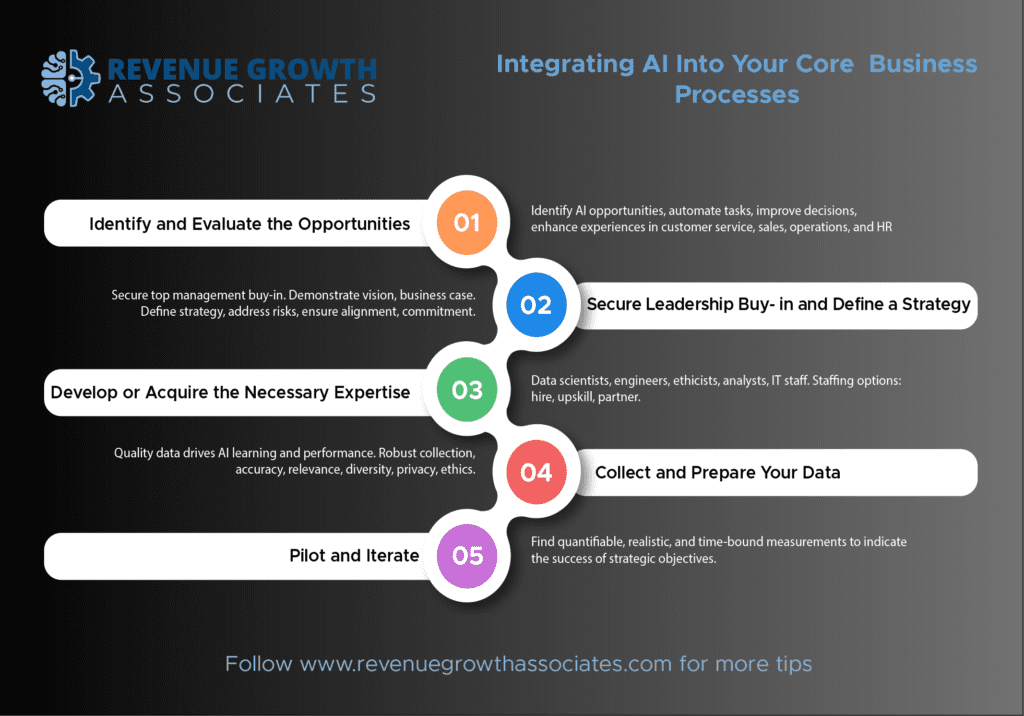The rise of artificial intelligence (AI) in the business world has brought a paradigm shift in the way organizations function and serve their customers. However, integrating AI into your core business processes isn’t a plug-and-play operation. It requires strategic planning, resource allocation, and a comprehensive understanding of both AI technology and your own business operations. Here are the first five steps an organization needs to take to embark on this transformative journey.
1. Identify and Evaluate the Opportunities: The first step in integrating AI into your business is identifying the areas where AI can deliver the most value. Analyze your core business processes and look for opportunities to automate routine tasks, improve decision-making, and enhance customer experiences. Potential areas for AI implementation could include customer service (chatbots), sales (predictive analysis and guidance), operations (process automation and analytics), and HR (talent acquisition and development).
2. Secure Leadership Buy-in and Define a Strategy: Before you embark on an AI journey, it’s crucial to secure buy-in from top management. Demonstrating a clear vision and business case for AI can help to achieve this. Define a strategy that outlines the purpose, goals, and methodology for AI implementation. Your strategy should also address potential risks and establish a plan to manage them. This step is essential to ensure alignment and commitment from all levels of the organization.
3. Develop or Acquire the Necessary Expertise: Implementing AI solutions requires a specific set of skills and expertise. You’ll need data scientists for developing and training AI models, data engineers to handle large volumes of data, and AI ethicists to ensure ethical considerations are addressed. In addition, you’ll require business analysts to interpret and apply AI outcomes, and IT staff to integrate AI technologies into existing systems. Depending on your existing capabilities, you may need to hire new staff, upskill current employees, or partner with an external AI service provider.
4. Collect and Prepare Your Data: AI systems learn and improve from data. The quality and quantity of your data directly impact the performance of your AI solutions. It’s vital to have robust data collection and management processes in place. Your data needs to be accurate, relevant, and diverse to train your AI models effectively. Additionally, respect for privacy regulations and ethical considerations around data usage is paramount.
5. Pilot and Iterate: Before going all in, start with a pilot project that has a clear objective and is relatively easy to implement. This approach allows you to assess the effectiveness of the AI solution, adapt it to your specific needs, and learn valuable lessons before scaling it up. Remember that AI integration is not a one-off project but a continuous process of learning and adaptation.
By following these steps, you’re setting a strong foundation for integrating AI into your core business processes. Keep in mind that this is a transformative process that will likely require changes in your organization’s culture, structure, and operations. It’s not without its challenges, but with careful planning and execution, AI can unlock tremendous value for your organization, propelling you to new levels of productivity and innovation.
Need help? Contact us at www.revenuegrowthassociates.com. Our experts can help you with all aspects, from strategic planning to execution.
#AIStartingpoint #RevenueGrowth #AITransformation #BusinessStrategy #ExecutionMatters


